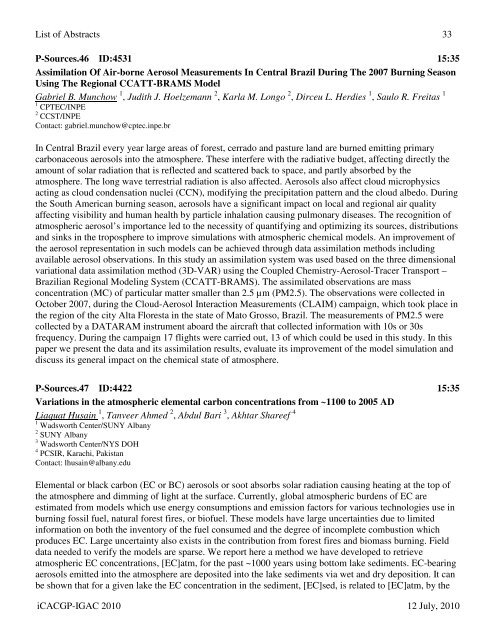Download Abstracts Here - IGAC Project
Download Abstracts Here - IGAC Project
Download Abstracts Here - IGAC Project
Create successful ePaper yourself
Turn your PDF publications into a flip-book with our unique Google optimized e-Paper software.
List of <strong>Abstracts</strong> 33P-Sources.46 ID:4531 15:35Assimilation Of Air-borne Aerosol Measurements In Central Brazil During The 2007 Burning SeasonUsing The Regional CCATT-BRAMS ModelGabriel B. Munchow 1 , Judith J. Hoelzemann 2 , Karla M. Longo 2 , Dirceu L. Herdies 1 , Saulo R. Freitas 11 CPTEC/INPE2 CCST/INPEContact: gabriel.munchow@cptec.inpe.brIn Central Brazil every year large areas of forest, cerrado and pasture land are burned emitting primarycarbonaceous aerosols into the atmosphere. These interfere with the radiative budget, affecting directly theamount of solar radiation that is reflected and scattered back to space, and partly absorbed by theatmosphere. The long wave terrestrial radiation is also affected. Aerosols also affect cloud microphysicsacting as cloud condensation nuclei (CCN), modifying the precipitation pattern and the cloud albedo. Duringthe South American burning season, aerosols have a significant impact on local and regional air qualityaffecting visibility and human health by particle inhalation causing pulmonary diseases. The recognition ofatmospheric aerosol’s importance led to the necessity of quantifying and optimizing its sources, distributionsand sinks in the troposphere to improve simulations with atmospheric chemical models. An improvement ofthe aerosol representation in such models can be achieved through data assimilation methods includingavailable aerosol observations. In this study an assimilation system was used based on the three dimensionalvariational data assimilation method (3D-VAR) using the Coupled Chemistry-Aerosol-Tracer Transport –Brazilian Regional Modeling System (CCATT-BRAMS). The assimilated observations are massconcentration (MC) of particular matter smaller than 2.5 µm (PM2.5). The observations were collected inOctober 2007, during the Cloud-Aerosol Interaction Measurements (CLAIM) campaign, which took place inthe region of the city Alta Floresta in the state of Mato Grosso, Brazil. The measurements of PM2.5 werecollected by a DATARAM instrument aboard the aircraft that collected information with 10s or 30sfrequency. During the campaign 17 flights were carried out, 13 of which could be used in this study. In thispaper we present the data and its assimilation results, evaluate its improvement of the model simulation anddiscuss its general impact on the chemical state of atmosphere.P-Sources.47 ID:4422 15:35Variations in the atmospheric elemental carbon concentrations from ~1100 to 2005 ADLiaquat Husain 1 , Tanveer Ahmed 2 , Abdul Bari 3 , Akhtar Shareef 41 Wadsworth Center/SUNY Albany2 SUNY Albany3 Wadsworth Center/NYS DOH4 PCSIR, Karachi, PakistanContact: lhusain@albany.eduElemental or black carbon (EC or BC) aerosols or soot absorbs solar radiation causing heating at the top ofthe atmosphere and dimming of light at the surface. Currently, global atmospheric burdens of EC areestimated from models which use energy consumptions and emission factors for various technologies use inburning fossil fuel, natural forest fires, or biofuel. These models have large uncertainties due to limitedinformation on both the inventory of the fuel consumed and the degree of incomplete combustion whichproduces EC. Large uncertainty also exists in the contribution from forest fires and biomass burning. Fielddata needed to verify the models are sparse. We report here a method we have developed to retrieveatmospheric EC concentrations, [EC]atm, for the past ~1000 years using bottom lake sediments. EC-bearingaerosols emitted into the atmosphere are deposited into the lake sediments via wet and dry deposition. It canbe shown that for a given lake the EC concentration in the sediment, [EC]sed, is related to [EC]atm, by theiCACGP-<strong>IGAC</strong> 2010 12 July, 2010








